Home Statues Jackie Robinson Babe Ruth The Story Ephemera Paintings Contact Us
The Story: Page 1
Carving wood into things and then later, people, started
innocently. I never set out to become a sculptor, but somehow, it happened.
As a kid, I suppose I drew a lot with the crayons and later pen and pencil, but I
didn't produce anything of note; I just liked the act of drawing itself. I went
to college for Accounting at a top business school but felt a little out of
place creativitiy-wise. Then, on Christmas break in 1989, I was home at my
parents' and I used a Dremel die grinder for the first time.
It was a gift to my father for his Bonsai hobby. Bonsai is the art of dwarfing trees and
making them look real and the grinding tool was to shape the dead limbs.
I took the grinder and found a piece of wood and quickly turned
out a relief carving of Buffalo Nickel. For a variety of reasons, I wasn't very happy during this period
of my life, but I did find great joy in the the activity of sitting for hours and
making wood turn into various things. I can recall being amazed at the fact
that I had done it --and rather easily too. Add to this, the fact that friends
and family made a fuss over it, and naturally, I was hooked. As I got more confident in my abilities,
I did a few more smaller items and some duck decoys and then quickly scaled up my ambitions.
While reflecting on the thought that one of the hardest things to do was the small detail
required by the nick-nack sized items that I was doing, it occurred to me that perhaps what
would be fun would be to do a life-size figure. The first thing
you think of, when you think "life size" is a cigar store Indian but somewhere along the line I
realized that a cigar store Indian is a cliche and what I really liked was
baseball; so why not do a large Babe Ruth figure? Since I was just out of
business school, I thought that the project should have as its goal, that the
piece be sold or at least be saleable. With the news of the day being filled with stories
of people paying larger and larger sums for anything connected with baseball
memorabilia, Babe Ruth, it was. I used wood that I had saved from the fireplace--great big blocks
of Black Walnut that made you wonder why anyone would cut it into fireplace
lengths, but there it was. Below is the only surviving shot of the
Walnut in block form. Ask any woodcarver who's had the pleasure of working
with Walnut and they'll tell you it's God's gift to woodworkers, possessing the hardness of a hardwood but yet still being workable. And it
smells great when burned--nice and sweet. There were a few times that I
fired up the woodburner and just made a little Black Walnut smoke in the shop.
I started almost immediately hacking out the shoes from the walnut with a
chisel. I made a lot of noise, I made a lot of chips and I tried to keep
my mouth shut until I had something to show people. Somewhere along the
line, I told people of the plan. Man O'man, did I hear it. "You are
carving a WHAT?", and the best one, "WHY?" Maybe the idea of selling it
came out of those discussions, you know, as a way to save face and defend the
goofy project? I don't clearly remember but I do know that selling it was
part of the plan almost from the beginning, if not the beginning. How much
of this work would I do today with the chisel by hand? Not much.
Mostly, I'd use the bandsaw and chainsaw and get to my basic figure in about 30%
of the time. But the chipping and chiseling is just the thing for a
newbie, because, nothing happens too fast, you know? You have plenty of
time to plan and see the thing coming along and I think it sharpens your eye.
Later on, when you are an impatient crackerjack, then sure, go ahead and break
out the power tools.
Next

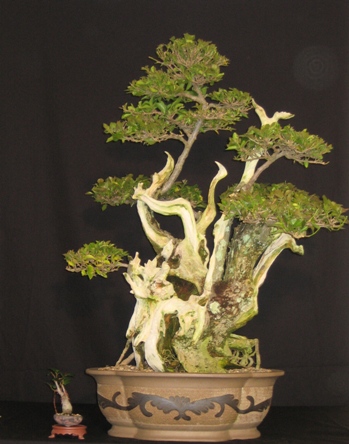
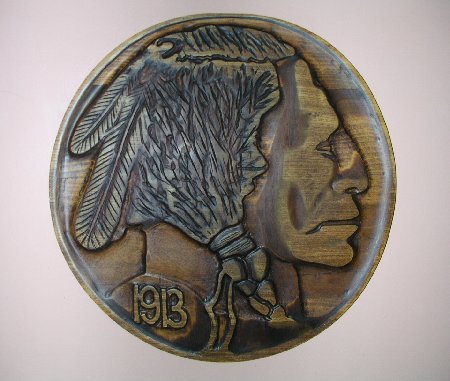
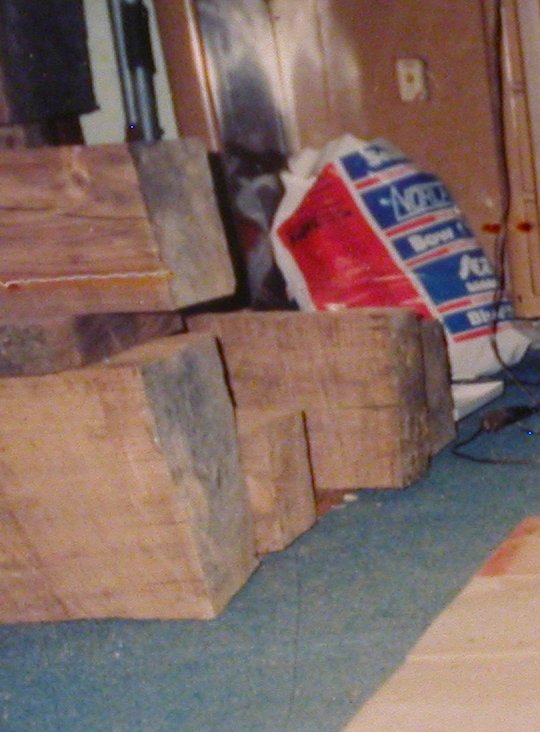
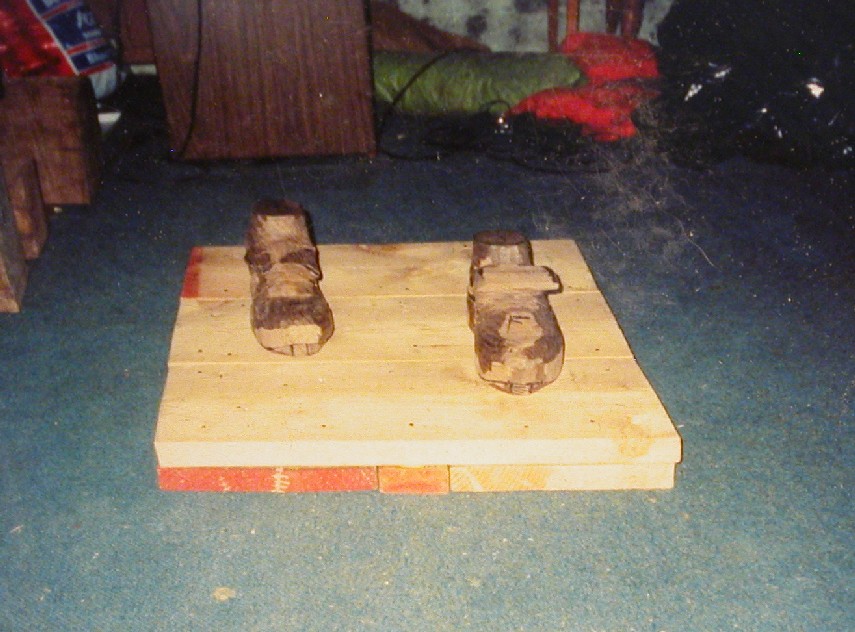
The pose I chose came from a book called The Ultimate Baseball Book. It was not the typical Babe Ruth action pose. It was a simple pose, where Ruth stood and his bat was laid across his upper thighs. I figured that the figure, being solid wood, would be very heavy and that structural soundness was going to be an issue, so I did not want any pose that would be "weak". Here I am recreating the pose for some reason or another that I have since forgotten. Behind me, you can see the Walnut piled up.
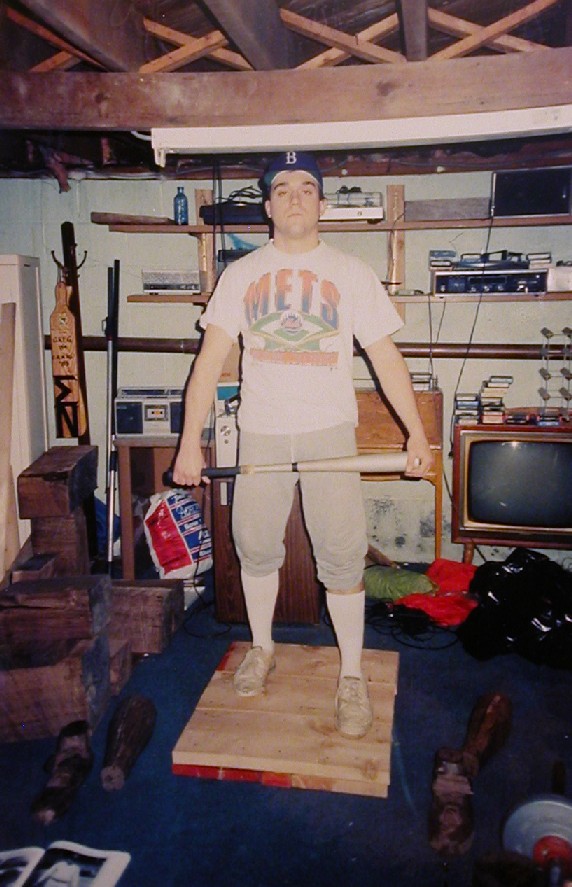
I can remember being so intimidated by the body building that I made Plaster of
Paris blanks to kind of eye it up. I cringe at the time wasted now but at
the time, I know it helped because I was working the problem. I also made
cardboard silhouettes and stacked them up. It was the same idea, I didn't
trust myself to get the dimensions right, so I added an almost useless step to
the process--one that I have never repeated.
Here is the cardboard experiment at its height. Looking back, I'm pretty
sure that the detours into Plaster of Paris and cardboard were just sheer
avoidance and fear. I needed to just get on with it. I suppose the case could be made
that it saved me wood and gave me a pattern to cut out the stock from. I'm not sure that it worked however.
On the base is a
xerox of "The Pose" from the Ultimate Baseball Book. That's the "master"
photo for the statue.
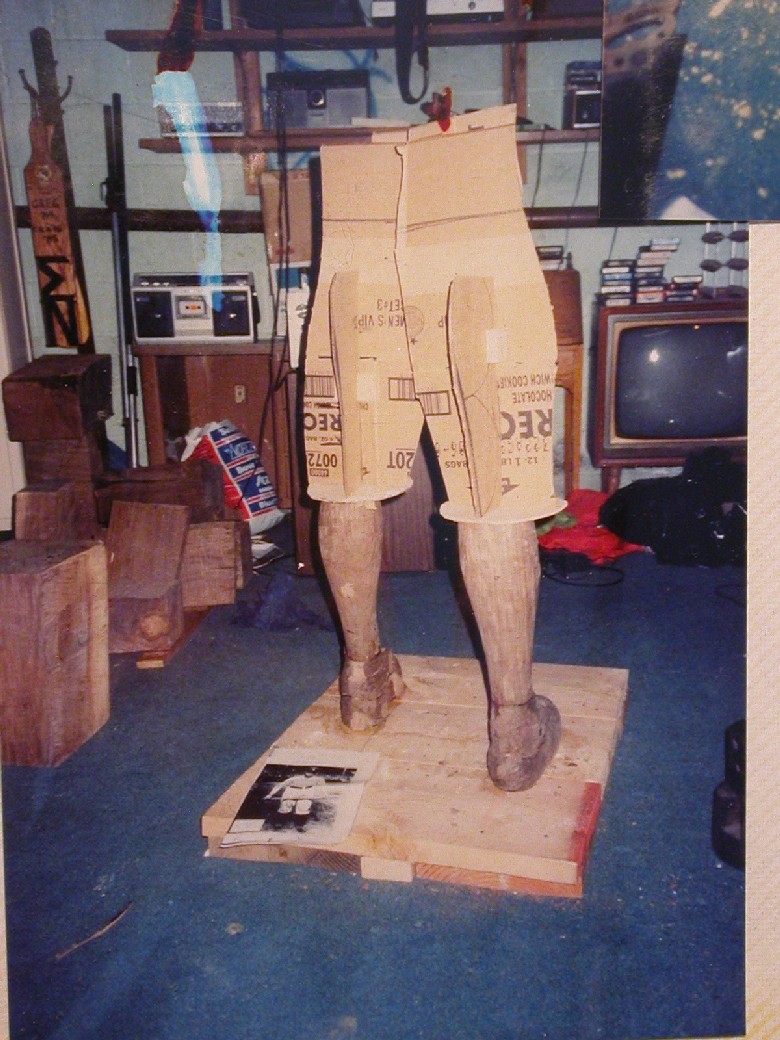
Somewhere along the line, after I had hacked out the shoes and shins from Black Walnut by hand with a small gouge, I realized that I needed a LOT of wood in a hurry. I do not remember to this day how I originally found John Wickenheisser of Wedge Cabinet, but I did. And I drove down to his shop in the shadow of Giants Stadium in Moonachie, NJ and walked in. I didn't know him and he could easily have given me the heave-ho, but he didn't. And I've often thought in later years, that if your life comes down to a handful of moments, that was one of my moments. I've always wondered what would have happened to me if John hadn't been so kind to me and helped me out in a hundred ways with advice, materials, custom work, expertise and friendship. He is a tough old German-American cabinet maker and he pulls no punches but yet he is as big a patron of the arts as you'll ever see, because he supports and backs woodcarving and woodcarvers. He does it for many reasons, I'm sure; business being one of them, but there is also something more and I've often thought about it and the best I can figure is that he appreciates anyone who can do quality work with wood. And if he didn't take the time to help out the skittish kid with the crazy idea, I don't know for sure if I would have done anything in wood that followed.
Here is JJ Wick at one of the numerous shows we did with John selling his wood and me, the ballplayers
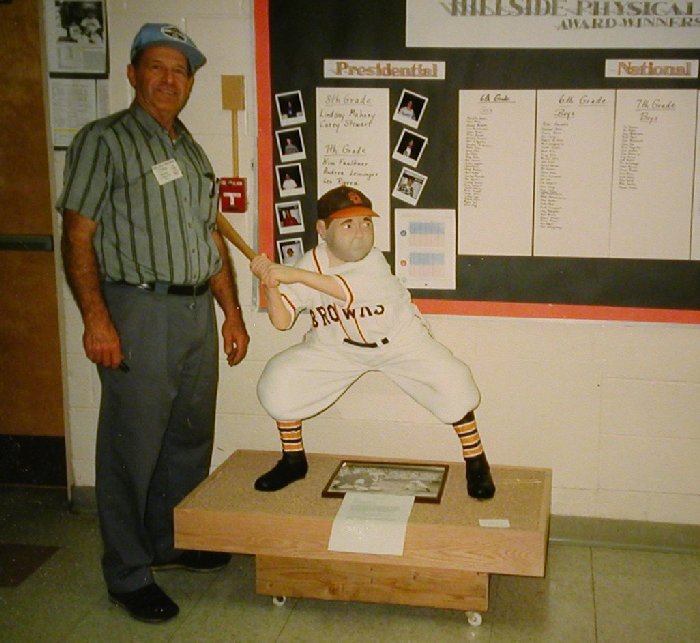
He had a load of 3 inch pine that he bought on a hunch from a sawmill a few years before. A job had been cut and the buyer skipped out and so it was sitting in a pile and John bought it all. Since that time I have bought it all from him and it is now all over the country in the form of Ruth, Mantle, DiMaggio and Gaedel. So it worked out and the wood was nice. Big pieces of clean and dry pine that worked almost like pumpkin at times. I began to build up the figure on the top of the shins, drilling and dowling as I went for strength. I now realize that I completely overbuilt that piece and it may actually survive a nuclear war but at the time, I wasn't going to have the thing fail for something I skimped on. Needless to say, all the overbuilding slowed me down immeasurably. And I was such a dummy that I laid all the wood so that I would always be carving endgrain, which is much harder to work. When you carve at a right angle to the grain (endgrain) the chips are small and they fly off the head of the chisel at high velocity and come right up the shaft of the chisel and hit you in the eye!
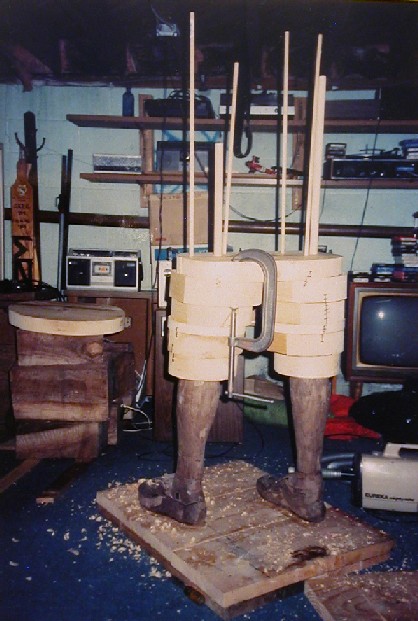
I remember distinctly, as I built up the body, that I had no idea if I could carve realistic hands or a good likeness and realistic head! I thought and worried about it often. And when the figure got above waist high, I got going on the hands. Hands take a long time to carve because they are very detailed. You have to use a harder wood than pine to "hold" all that detail. The softer the wood, the less detail you can carve into it. So you do the head and hands in Basswood, the traditional German carving wood going back to the middle ages. It's also still in use as the number 1 carving wood, but it is expensive. So you use the pine for the body and the Basswood for the head and hands.
When carving hands, I always use my own hands as models. All my statues have my hands. No one, not even the guy's mother, would notice this and unless I'm doing a 7 foot tall basketball player, where it might matter, I will continue this. But to hold the wood in one hand and the die grinder in the other and carve means that you have to put down the wood and tool and pick up the bat piece and look at it and study it and draw some lines, perhaps, on the carving and then pick up the tool and carving and do some work and then repeat. It gets tedious and time consuming. I have molded my hands in plaster to speed this up but it only goes so far in helping.
The hands for the Mickey Mantle Statue at left and the Plaster of Paris mold of my hands at right. The black marks on the wood are the result of a wood burner for details and the dust collector can be seen at top right.
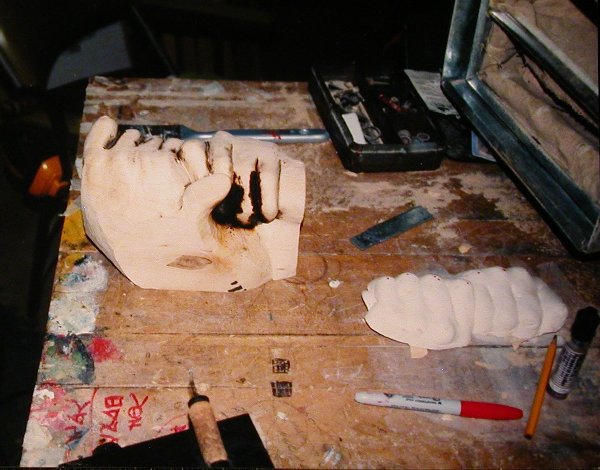
After the hands turned out far better than I could have ever imagined, I was hooked. This was it. This was the point at which I knew I had something neat going on and this marked the point beyond which, I knew I was going to see this thing through. Sure, the head intimidated me, as I had never done it before, but my first crack at the hands gave me the confidence to go ahead. I can't tell you the feeling adequately, of struggling all night long for 3 or 4 hours straight with the grinders, and knocking off puffs of wood from here and there, here and there. And then at the end of the night, you look up and realize that the thing looks real. There is always a moment and it usually always comes at the end of the night when you stop focusing on details and see the thing as a whole, maybe, but that moment is a tremendous zing. I'm not going to say it's an out-of-the-body experience or any such drama, but it is powerful, because you just don't believe that you actually produced the thing! And you don't seem to notice it along the way, because the progress is just so darned slow that you don't see change in a smooth way, but rather all in big clumps. The feeling never gets old, even though you get more used to it, if that makes any sense. And you can't bank on it either--it's not regular or predictable, but it most often follows periods of sustained effort. Hard work.